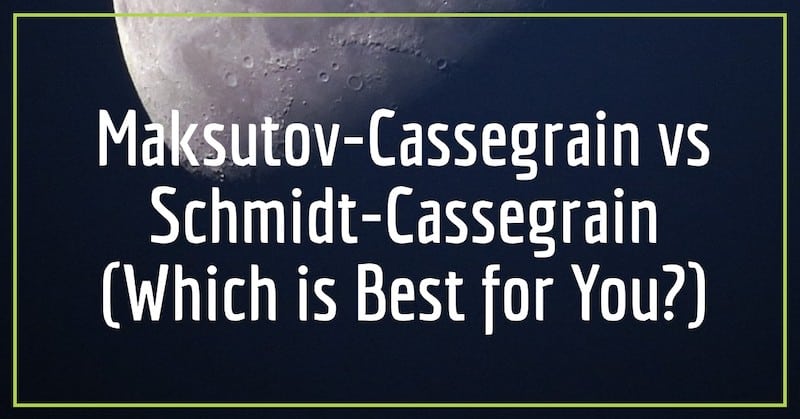Maksutov-Cassegrains and Schmidt-Cassegrains are two of the most popular telescope types on the market and there are a number of great models available of both.
But what are the pros and cons of each that you should know about when considering buying?
In this article, we examine Maksutov-Cassegrain vs Schmidt-Cassegrain and outline the advantages and disadvantages of each to help you decide what is right for you.
Maksutov-Cassegrain vs Schmidt-Cassegrain: Two Types of Catadioptric Telecope
Schmidt-Cassegrain and Maksutov-Cassegrain telescopes are examples of catadioptric (or compound) telescopes.
This simply means that they are a class of telescope that contain a combination of lenses and mirrors.
This is in contrast to the other two main types of telescope:
- Refractors – contain only glass lenses
- Reflectors – contain only mirrors
Catadioptrics are great because they are compact, easy to use, and capable of delivering high-quality images.
The downsides are that they are generally most expensive, require collimating, and need time to adjust to the outside air temperature before they can be used.
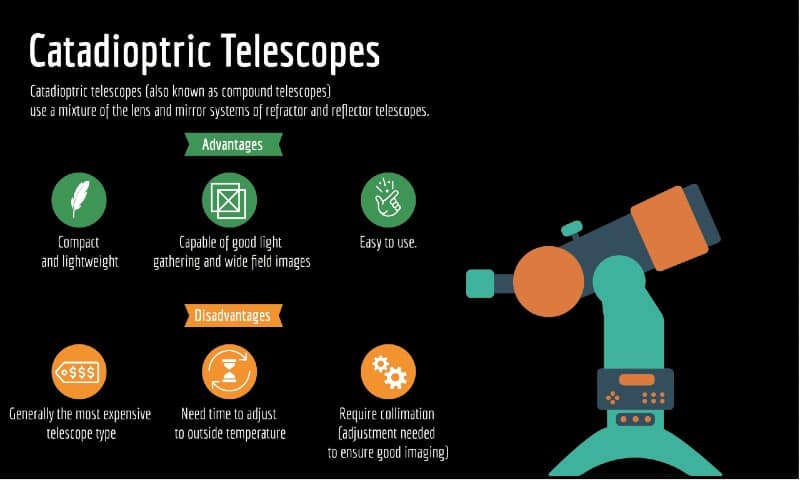
If you want to read more about how the three types of telescope compare go to Refractors vs Reflectors vs Catadioptrics.
Let’s now look at the differences and similarities between Maks and Schmidts.
What is a Maksutov-Cassegrain Telescope?
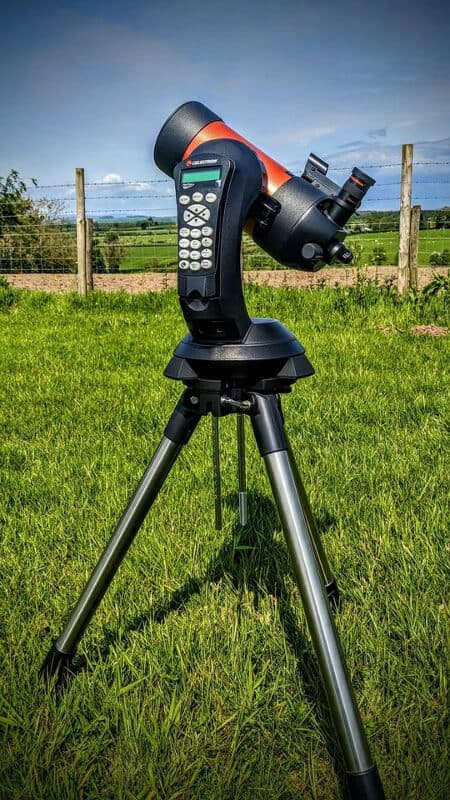
The name Maksutov-Cassegrain comes from:
- Maksutov: The name of the inventor – Dmitry Dmitrievich Maksutov, a Russian optical engineer and astronomer.
- Cassegrain: Part of the family of Cassegrain telescopes that are characterized by having primary and secondary mirrors.
Maksutov-Cassegrain telescopes (“Maks”) consist of these primary and secondary mirrors along with what is called a meniscus corrector lens that eliminates aberrations caused by the design.
You can read more about the technical aspects on the Wikipedia page.
What is a Schmidt-Cassegrain Telescope?
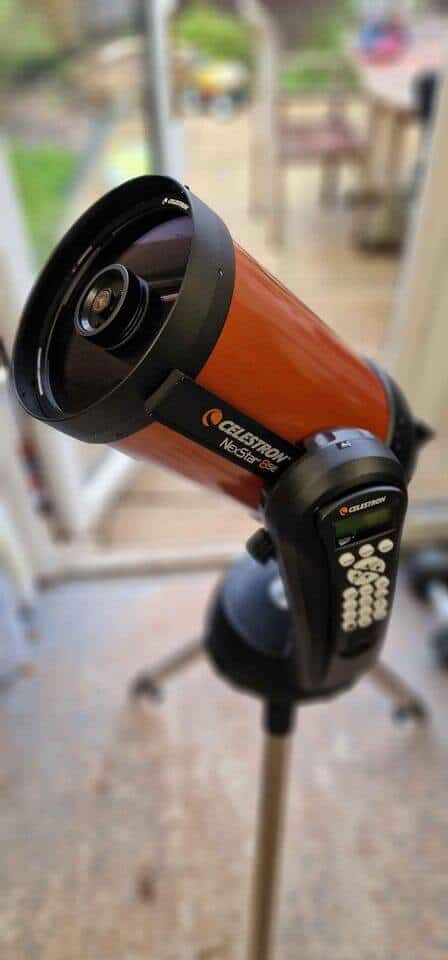
The name Schmidt-Cassegrain comes from:
- Schmidt: Named after Bernard Schmidt who invented the Schmidt Camera in 1930.
- Cassegrain: Again, part of the Cassegrain family of telescopes.
Like a Maksutov-Cassegrain, a Schmidt-Cassegrain Telescope (SCT) consists of primary and secondary mirrors but has what is called a Schmidt Corrector Plate to correct for aberrations. This is what is different between the two designs – different types of corrector plate.
You can read more about the technical aspects on the Wikipedia page for Schmidt Cassegrains but let’s now get more into the pros and cons of each of these telescope types.
Maksutov-Cassegrain and Schmidt-Cassegrain Advantages and Disadvantages
Both Maks and SCTs have a number of shared positives:
- They are compact and allow for a less bulky, more portable telescope tube in relation to aperture.
- They are light which makes them more portable and easier to handle and for your mount to require a lower maximum payload capacity.
- They have long focal lengths of about 5-7 times longer than the tube length due to the mirror system. This makes them great for observing the planets and moons of our solar system where having a narrow zoomed-in view is an advantage.
The disadvantages that they can have are:
- They tend to be fairly expensive, at least in comparison to reflector telescopes of the same aperture. This is the payoff for the smaller, lighter and more compact design, whereas reflector telescopes tend to be big, bulky and heavy.
- The long focal length gives a narrow field of view, which is a positive for planetary and lunar viewing, but a downside for wide-field deep-sky objects.
- Like reflector telescopes (but unlike refractors) they may require collimation from time to time.
- They tend to be bigger and heavier as the aperture goes up. They will still be smaller than reflectors or refractors with the same aperture, but the bigger SCTs do get big and will require mounts with high payload capacities.
So that’s the similarities, now let’s look at how Maks and SCTs differ from each other.
Maksutov-Cassegrain Pros and Cons
The advantages of Maksutov-Cassegrain telescopes are that:
- The optical quality of a Mak design is generally superior to that of an SCT of the same aperture because the design has a smaller central obstruction which means better contrast. However, this is not always the case and varies by model.
- Maks generally require less maintenance and are usually factory-collimated in advance with less need to do this yourself.
The disadvantages are:
- Relative to aperture, Mak’s are generally more expensive than SCT’s since the corrector plate it uses is more expensive to manufacture. This is especially an issue for larger telescopes where this becomes an even greater issue.
- Maks generally take longer to adjust to outside air temperatures than SCTs, especially for larger apertures due to the extra thickness of the corrector plate. This means you have to wait longer to use it after setting up outside or your views will be compromised.
- Maks have slower focal ratios, making them less suited to astrophotography than SCTs. They also generally have narrower fields of view.
- Maksutov-Cassegrain telescopes are much less commonly available to buy. This is mostly for the reasons above where they get prohibitively expensive once they get over a certain size.
- For a given aperture, Maks are heavier than SCTs.
Schmidt-Cassegrain Pros and Cons
The advantages of SCTs over Maks are:
- They are cheaper in relation to aperture, especially as this gets larger.
- They adjust quicker to cooler outside temperatures and so there is less time waiting between getting set up and using them.
- They generally have faster focal ratios and slightly wider fields of view, making them better for astrophotography. Some models can the in-built technology to adjust for much faster focal ratios (for example, those SCTs with Celestron’s Fastar tech).
- They are more commonly available and there are a lot more high-quality options, even at higher apertures.
- They are lighter than Maks of the same aperture.
The disadvantages are:
- SCTs can be less hardy due to the more fragile components.
- They can require more maintenance and collimation.
- In terms of aperture inch-for-inch, SCTs will generally have lower image quality to Maks, although this can vary hugely from model to model.
Maksutov vs Schmidt for Astrophotography
Whilst both Maks and SCTs can be used for astrophotography, our research shows that Schmidt-Cassegrain telescopes are far more successful for this.
We worked this out by analyzing nearly 400 images shortlisted that were shortlisted for the Astronomy Photographer of the Year competition in the past three years (2019-2021). You can see the full results of this analysis here.
For our purposes right now, we can look at how many images were taken with SCTs and how many were taken with Maks, and the Schmidt-Cassegrain is the clear winner.
From 189 images that used telescopes, 41 used Schmidt’s and just 1 used a Maksutov (the remaining 141 were refractors, reflectors, and other types of Cassegrain telescope):
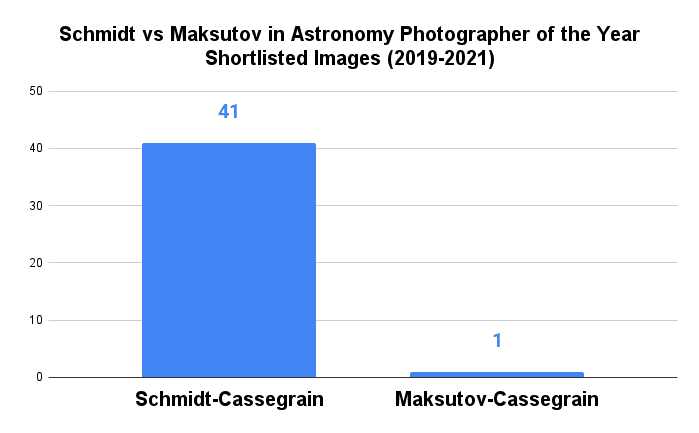
This needs to be seen in the light of the information above in that SCTs of larger aperture are much more common and affordable and therefore are more likely to be being used by experienced astrophotographers.
It’s also worth noting that of the 41 images that used SCTs:
- 33 were planetary or lunar images
- 8 were deep-sky images
This reinforces the point that SCTs (and Maks) are mostly better for planetary and lunar observing and imaging, over viewing or photographing wide-field deep-sky objects.
See the Best Telescopes for Astrophotography for a greater dig into this data, and the Best Telescopes For Planetary Imaging for planetary-specific info.
FAQs: Schmidt vs Maksutov Cassegrain
What are the best Schmidt-Cassegrain telescopes?
The most popular Schmidt-Cassegrain telescopes include:
- Celestron Nexstar 5SE, 6SE, and 8SE
- Celestron 8, 9.25, 11 and 14-inch OTAs
- Meade Instruments 14 and 16-inch Advanced Coma-Free (ACF) Telescopes
What are the best Maksutov Cassegrain telescopes?
The most popular Maksutov-Cassegrain Telescopes include:
- Celestron Nexstar 4SE, 90SLT and 127SLT
- Sky-Watcher SkyMax and others
- Celestron C90 and C70 Spotting Scopes
SCTs and Maks can be bought as standalone telescope tubes (Optical Tube Assembly – OTA) or as part of packages that include tripod, mount, and other accessories like eyepieces and barlow lenses.
Which is better Schmidt Cassegrain or Maksutov Cassegrain?
There is no strict “better”. Maks make great value telescopes at lower apertures but get disproportionately more expensive as they get larger.
SCTs are more commonly available at larger apertures and are extremely popular whilst providing great value.
Do you have to collimate a Maksutov Cassegrain telescope?
Maks are generally factory-collimated in advance and do not usually require any further maintenance.
What are Schmidt Cassegrain telescopes good for?
Schmidt Cassegrain telescopes are particularly good for viewing the planets and objects of our solar system due to their long focal lengths and narrow fields of view.
Conclusion: What is better – Maksutov or Schmidt Cassegrain?
Maksutovs-Cassegrains and Schmidt-Cassegrains are two similar types of catadioptric telescopes that differ in the internal design of the corrector plates.
They are both compact telescopes with long focal lengths that are great for amateur astronomers and astrophotographers, especially for planetary viewing and imaging.
The main differences between the two are:
- Maks provide great value and quality optics in lower aperture models. As they get bigger they get much more expensive than SCTs.
- Maks are hardier and require less maintenance and collimation
- SCTs are more suited to astrophotography with faster focal ratios, although both Maks and SCTs tend to have long focal lengths and narrow fields of view which make them best for planetary imaging, over deep-sky.
- SCTs are much more commonly available and more affordable, especially at higher apertures.
It is not the case that one is better than the other. For the most part, there are some great Maks around the 4-inch aperture mark that provide great value for astronomy.
SCTs can be much bigger with higher aperture, there are more models on the market to buy, and they are better for astrophotography.
We hope you found that useful. See the Best Telescopes for Astrophotography for more on this topic.


